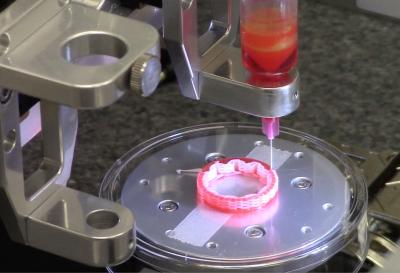Two materials used at once better fabricate trachea constructs

Credit: Credit: WFIRM
WINSTON-SALEM, NC, — Dec. 4, 2019 — Wake Forest Institute for Regenerative Medicine (WFIRM) scientists are the first to report using bioprinting to print a tracheal tissue construct comprised of multiple different functional materials. They printed different designs of smooth muscle and cartilage regions in artificial tracheal substitutes showing similar mechanical properties to human tracheal tissue.
Previous attempts of tissue engineered tracheal constructs have presented many different limitations, mainly because they focused only on using regenerated cartilage tissue. The WFIRM tracheal constructs are novel in that they were bioprinted with separate cartilage and smooth muscle regions at the same time using a biodegradable polyester material and hydrogels containing human mesenchymal stem cells which can self renew and can become a variety of cell types. In this case, the stem cells differentiated into two different cell types — chondrocytes and smooth muscles cells — in different regions of the bioprinted tracheal constructs. The cartilage portion is stiff to provide mechanical support to avoid collapse while the smooth muscle is pliable and connects the ends of the cartilage rings, allowing sufficient flexibility for airway contraction.
“People have tried other materials, but the problem has been they were using just one material that is not strong enough to hold the airways open and does not provide the flexibility needed. Our bioprinting method provides a combination of flexibility and strength needed to mimic native tracheal tissue,” said Sean Murphy, PhD, lead author and assistant professor of regenerative medicine at WFIRM.
The trachea is a hollow tube that is made of cartilage and smooth muscle tissue designed to allow a flexible airway that resists collapse. Tracheal stenosis is the abnormal narrowing and stiffening of the trachea, which can be caused due to prolonged intubation, inflammation and trauma or it can be a congenital abnormality. The primary treatments for the condition, which is rare but life threatening, are surgical interventions that have challenges and limitations.
For this study, published online in the journal Biofabrication, the research approach combines three tailored technologies: patient specific medical imaging, hydrogels designed to drive differentiation of stem cells, and polymeric scaffolding mimicking specific biomechanical properties.
Murphy said the approach was to incorporate softer hydrogels containing stem cells into the pores of the bioprinted tracheal structures. “We already knew we could differentiate these cells in 2D into smooth muscle or cartilage, but the question of whether we could do that in bioprinted 3D constructs remained,” he said. “We added growth factors to help give them the extra push they needed.”
“This early proof-of-concept study shows that we can streamline bioprinting capabilities and could someday provide the opportunity for regenerative medicine treatments for the replacement of damaged or diseased tracheal regions,” said Anthony Atala, M.D., director of WFIRM and co-author of the paper. “Next steps in the research would be to evaluate long-term function to ensure appropriate tissue formation and strength retention.”
###
Co-authors include Dongxu Ke, Hualin Yi, Savannah Est-Witte, Sunil George, Carlos Kengla and Sang Jin Lee, all of WFIRM.
Editor’s note: Bioprinting b-roll is available.
Media Contact: Bonnie Davis, [email protected]; 336-713-1597.
About the Wake Forest Institute for Regenerative Medicine: The Wake Forest Institute for Regenerative Medicine is recognized as an international leader in translating scientific discovery into clinical therapies, with many world firsts, including the development and implantation of the first engineered organ in a patient. Over 400 people at the institute, the largest in the world, work on more than 40 different tissues and organs. A number of the basic principles of tissue engineering and regenerative medicine were first developed at the institute. WFIRM researchers have successfully engineered replacement tissues and organs in all four categories – flat structures, tubular tissues, hollow organs and solid organs – and 14 different applications of cell/tissue therapy technologies, such as skin, urethras, cartilage, bladders, muscle, kidney, and vaginal organs, have been successfully used in human patients. The institute, which is part of Wake Forest University, is located in the Innovation Quarter in downtown Winston-Salem, NC, and is driven by the urgent needs of patients. The institute is making a global difference in regenerative medicine through collaborations with over 400 entities and institutions worldwide, through its government, academic and industry partnerships, its start-up entities, and through major initiatives in breakthrough technologies, such as tissue engineering, cell therapies, diagnostics, drug discovery, biomanufacturing, nanotechnology, gene editing and 3D printing.
Media Contact
Bonnie Davis
[email protected]
336-713-1597
Original Source
https:/
Related Journal Article
http://dx.




